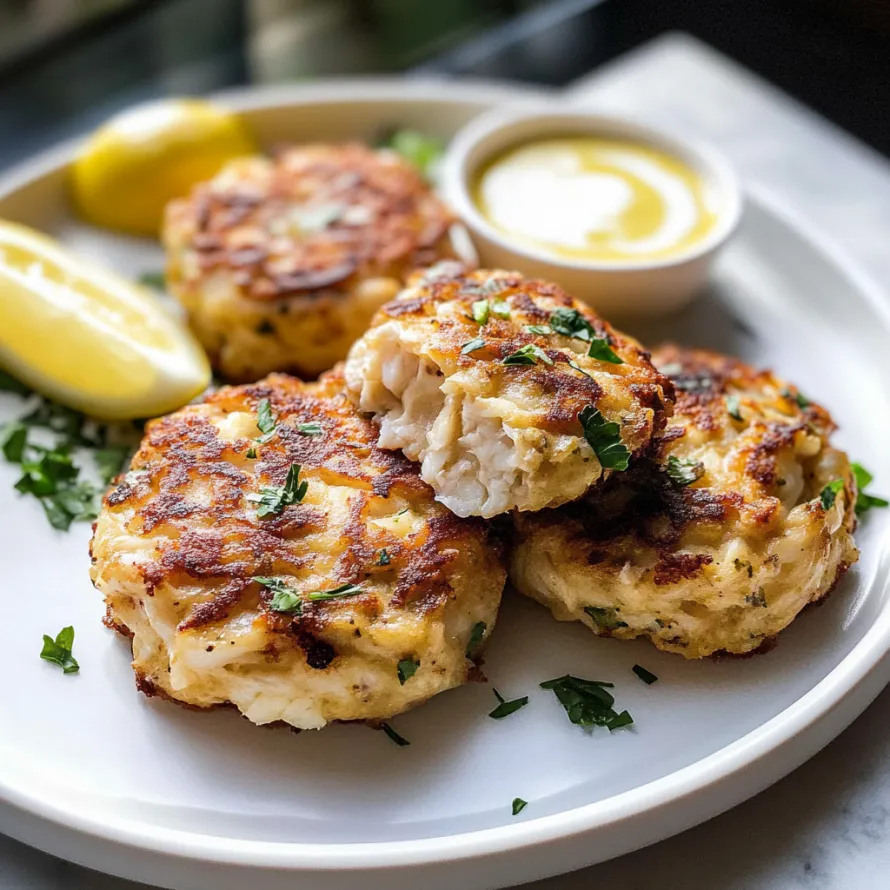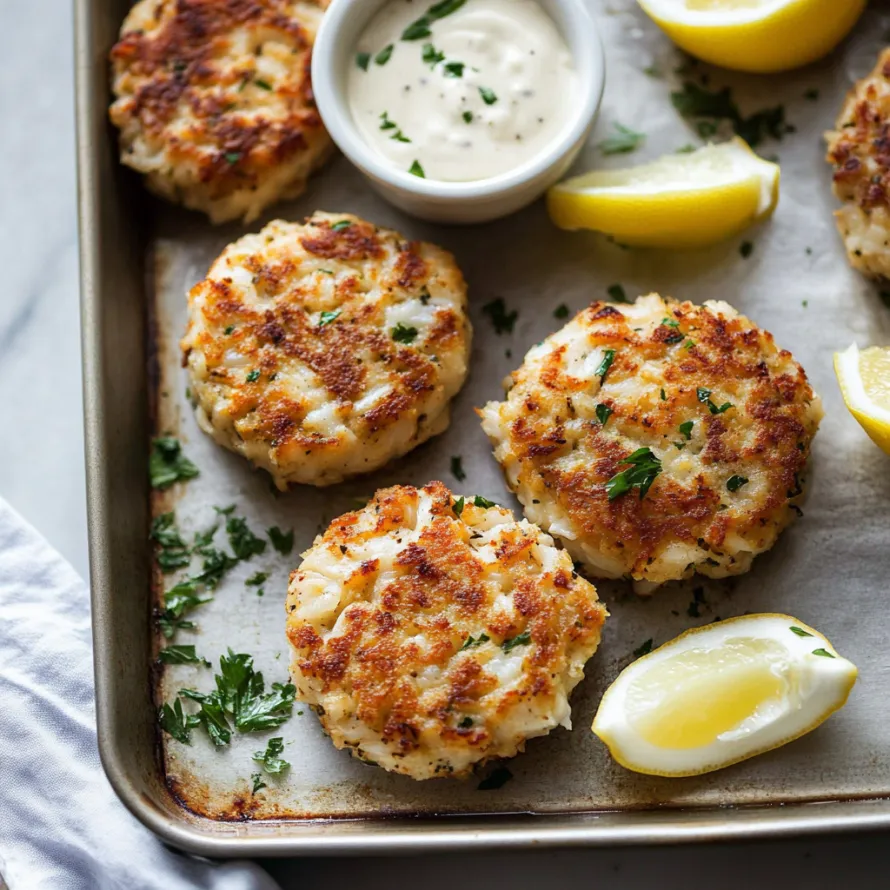 Pin it
Pin it
Sweet chunks of high-grade crab meat lightly held together with just the right seasonings bring you a true Maryland crab cake that shows off the natural tastes of Chesapeake Bay. These golden treats put seafood front and center, letting the juicy crab be the main attraction while other ingredients work quietly but importantly in the background. With hardly any fillers and tons of crab, these cakes bring you the real Maryland experience that seafood fans can't get enough of.
I got this recipe from my aunt who called Annapolis home for three decades. When I first tried making crab cakes, I stuffed them with too many extras. She kindly told me that folks from Maryland believe the best crab cake has as little added to good crab meat as possible. After trying her simple but amazing version, I tossed my complicated recipe for good. They've now become what I'm known for at special gatherings.
Top-Notch Ingredient Choices
- Lump crab meat: Gives you those big pieces that make the perfect texture. Try to find containers marked fresh-picked for the best taste.
- Saltine crackers: Add just enough to hold things together without standing out. Crushed finely, they soak up moisture but stay airy.
- Fresh parsley: Adds bright, herby notes that work well with crab's natural sweetness.
- Old Bay seasoning: Brings that real Maryland taste with its special spice mix.
- Fresh lemon juice: Wakes up all the flavors with a bit of tang that cuts through the richness.
- Quality mayonnaise: Adds wetness and helps everything stick without too much egg flavor.
- Dijon mustard: Gives depth but doesn't overpower the gentle seafood flavors.
Cooking Approach
- Mixing Method:
- Start by mixing egg, mayonnaise, parsley, Dijon mustard, Worcestershire sauce, Old Bay seasoning, lemon juice, and salt in a big bowl until everything's blended well. This makes a smooth base that spreads flavor evenly through the crab cakes. Add your crushed saltine crumbs and stir gently. The crackers will start soaking up moisture, making just the right binding texture. Last, add your precious lump crab meat and fold it in super carefully, using a rubber spatula or clean hands. You want to keep those nice big chunks of crab while making sure the seasonings reach everywhere.
- Resting Period:
- Cover your bowl with plastic wrap and stick it in the fridge for at least 30 minutes, though an hour works even better if you've got time. This key resting time lets flavors blend while the small amount of filler soaks up moisture, so your crab cakes stay together despite being mostly crab. The cold also makes the mix easier to shape. This little bit of waiting really pays off in how well your cakes hold up and feel when you eat them.
- Forming Technique:
- Heat your oven to 450°F for good browning and quick cooking that keeps moisture in. Grease a baking sheet well with butter or oil so nothing sticks. Use a half-cup measure to scoop the crab mix and gently shape into thick patties about 3 inches across. Don't press too hard - squeezing makes them dense instead of tender. For smaller appetizer sizes, use a quarter-cup instead. Put the shaped cakes on your greased sheet with some room between them.
- Baking Excellence:
- Before they go in the oven, brush each cake lightly with melted butter for flavor and color. Bake in your hot oven for about 12 to 14 minutes until golden on top and hot all the way through. The high heat cooks them fast, locking moisture inside while making a nice crust. Unlike frying in a pan, baking helps them keep their height without flattening, giving you those tall restaurant-style cakes that wow your guests.
My grandpa grew up on the Chesapeake Bay, where crab wasn't just food but part of daily life. He showed me that true Maryland crab cakes shouldn't have peppers, onions, celery, or loads of breadcrumbs. "Let the crab do the talking," he'd say while carefully picking meat from fresh blue crabs. This recipe follows his purist ways but makes sure the cakes stay together through good technique rather than packing in fillers.
Tasty Serving Ideas
For a fancy dinner, put two golden crab cakes on a small puddle of lemon butter sauce with fresh herbs and lemon wedges on the side. The simple sauce lets the sweet crab stay the main attraction. When making appetizers, try placing tiny crab cakes on small beds of microgreens with light citrus dressing, which nicely balances the rich seafood. For casual get-togethers, make crab cake sliders on toasted brioche buns with a thin spread of tartar sauce and fresh arugula.
 Pin it
Pin it
The first time I made these crab cakes for friends visiting from other states, their faces said it all. They looked so surprised when they tasted how different real Maryland crab cakes are from the bready versions they'd had before. The clean, sweet crab flavor instantly connects you to the Chesapeake region, where people have spent generations mastering the art of letting great seafood speak for itself. While this recipe needs some extra care and attention, the results give you a taste of Maryland that honors tradition and creates meals people won't forget.
Frequently Asked Questions
- → What’s the top choice for crab meat in this dish?
- Fresh lump crab meat is the gold standard for this dish! Its bigger pieces give the best flavor and texture. Though pricier, it outshines claw meat or canned options.
- → How far ahead can I prep these crab cakes?
- You can mix and shape the crab cakes up to a day before baking. Keep them tightly covered and refrigerated. Unbaked crab cakes also stay fine in the freezer for up to three months.
- → What do you mean by 'low-filler' crab cakes?
- Real Maryland crab cakes focus on letting the crab meat shine. This version uses just 2/3 cup of saltine crumbs to hold the cakes gently, instead of relying heavily on binders.
- → Can these be cooked in a skillet instead of an oven?
- Definitely! Heat 2 tablespoons of butter with 1 tablespoon of olive oil in a skillet on medium heat. Cook each side for 4-5 minutes until golden and warmed through.
- → What topping or sauces work well with them?
- Classic choices include tartar, remoulade, or cocktail sauce. A fresh squeeze of lemon is simple and delightful. For a twist, try lemon-garlic aioli or spicy mayo.
- → How can I tell the crab cakes are ready after baking?
- They’re ready when golden around the edges and on top, which takes about 12-14 minutes at 450°F. Since the crab meat is precooked, you’re just heating them through and crisping the exterior.
